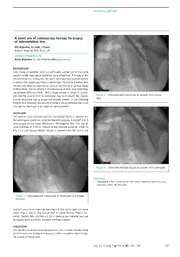
A novel use of colonoscopy forceps for biopsy of intervertebral disc. PDF
Preview A novel use of colonoscopy forceps for biopsy of intervertebral disc.
TECHNiCAL SECTiON A novel use of colonoscopy forceps for biopsy of intervertebral disc MD Wijeratna, AJ Cook, J Powell Ipswich Hospital NHS Trust, UK CORRESPONDENCE TO Malin Wijeratna, E: [email protected] BACKGROUND Core biopsy of vertebral bone is traditionally carried out in the prone position under radiological guidance using a trephine. If biopsy of the intervertebral disc is required, the same technique and instrumentation is used or fine-needle aspiration is performed. The biopsy obtained with the trephine relies on capillary action and the volume of sample tissue is often small. The sensitivity of this technique is poor, with rates rang- ing between 42% and 62%.1 With a larger sample of tissue, it is prob- Figure 2 Intraoperative fluoroscopy of sampler with closed able that the sensitivity of the technique may be improved. We propose jaws a novel technique (using equipment already present in the operating theatre) that increases the volume of sample tissue obtained and could improve the likelihood of an organism being isolated. TECHNiQUE The patient is placed prone and the core biopsy trocar is inserted un- der radiological guidance using standard techniques. A KyphX® size 3 bone biopsy device trocar (Medtronic, Minneapolis, MN, US) has an inner diameter of 2.9mm. Instead of the trephine supplied in the kit (Fig 1), a colonoscopy biopsy forceps is passed down the trocar, and Figure 3 Intraoperative fluoroscopy of sampler with open jaws Reference 1. Tehranzadeh J, Tao C, Browning CA. Percutaneous needle biopsy of the spine. Acta Radiol 2007; 48: 860–868. Figure 1 Intra-operative fluoroscopy of traditional core biopsy trephine multiple samples are taken by opening and closing the jaws to remove tissue (Figs 2 and 3). The Radial Jaw® 3 biopsy forceps (Boston Sci- entific, Natick, MA, US) has a 2.2mm opening jaw diameter and can be passed down a 2.8mm diameter working channel. DiSCUSSiON The use of a colonoscopy sampling device may increase the sensitivity of traditional core biopsy techniques to obtain a positive bacteriologi- cal culture or tissue type. Ann R Coll Surg Engl 2013; 95: 155–159 157 BANK Technical Section.indd 157 12/02/2013 08:56:38
